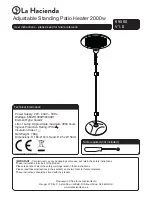
Pomona, CA Clemmons, NC Nashville, TN
Tel: 908-355-7995 www.hayward-pool.com
USE ONLY HAYWARD GENUINE REPLACEMENT PARTS
8
2. POOL/SPA WATER CHEMISTRY
The chemistry balance and mineral content of swimming pool water changes daily due to the addition of
pool and sanitizing chemicals, bather loads, rain, runoff and the amount of sun - to name a few. Improper chem-
istry balance and mineral content can cause scaling and deposits to form on pool walls, in the
fi
ltration system,
in the heat exchanger tubes and additionally can promote corrosive action to all metals in the water path. Chang-
ing spa water regularly and maintaining the correct chemical balance in your pool/spa will keep the pool/spa
safe and sanitary, and will help protect the heat exchanger. Use a 4-way pool/spa water test kit to check your
water frequently (at least weekly). Use the following guidelines to help protect your heater’s heat exchanger:
3. SKIMMER CHLORINATION
Placing chlorine or bromine tablets directly into the skimmer may result in high chemical concentrations
fl
owing through the heater. DO NOT place chlorine or bromine tablets in the skimmer.
4. CHLORINATOR INSTALLATION
Chlorinators must be installed downstream of the heater, and a check valve must be installed between the
heater and chlorinator to prevent high chemical concentrations from back
fl
owing into the heater. Make sure your
piping arrangement meets the chlorinator installation requirements shown on page 16.
5. BYPASS
Until water chemistry is properly balanced, and if your piping has a bypass valve installed for the heater,
open the bypass so that corrosive and potentially damaging water will not
fl
ow through the heater and there-
fore the heat exchanger. Close the bypass valve once the water is properly balanced. Failure to close the
bypass valve when attempting to operate the heater will result in extensive damage to the heat exchanger.
Ensure water
fl
ow through the heater is restored before operating the heater. A bypass feature is also advanta-
geous for service needs and for the ability to remove the heater from the water path when not heating. Refer
to page 15 for further information.
Recommended
Level
Effect of Low Levels
Effect of High Levels
Chlorine
1 - 3 ppm
Bromine
2 - 4 ppm
pH
7.4 - 7.6
corrosive to heat exchanger,
swimmer irritation
cloudy water, scaling of heat exchanger,
reduced sanitizer effectiveness
Total Alkalinity
80 - 120 ppm
corrosive to heat exchanger,
large fluctuations in pH
scaling of heat exchanger
Calcium Hardness
200 - 400 ppm
corrosive to heat exchanger
scaling of heat exchanger
Salt
2700 - 5000 ppm
poor salt chlorinator performance
corrosive to heat exchanger
hazy water, algea growth,
bacteria causing infections
swimmer irritation, bleaching of clothes/hair,
corrosive to heat exchanger









































